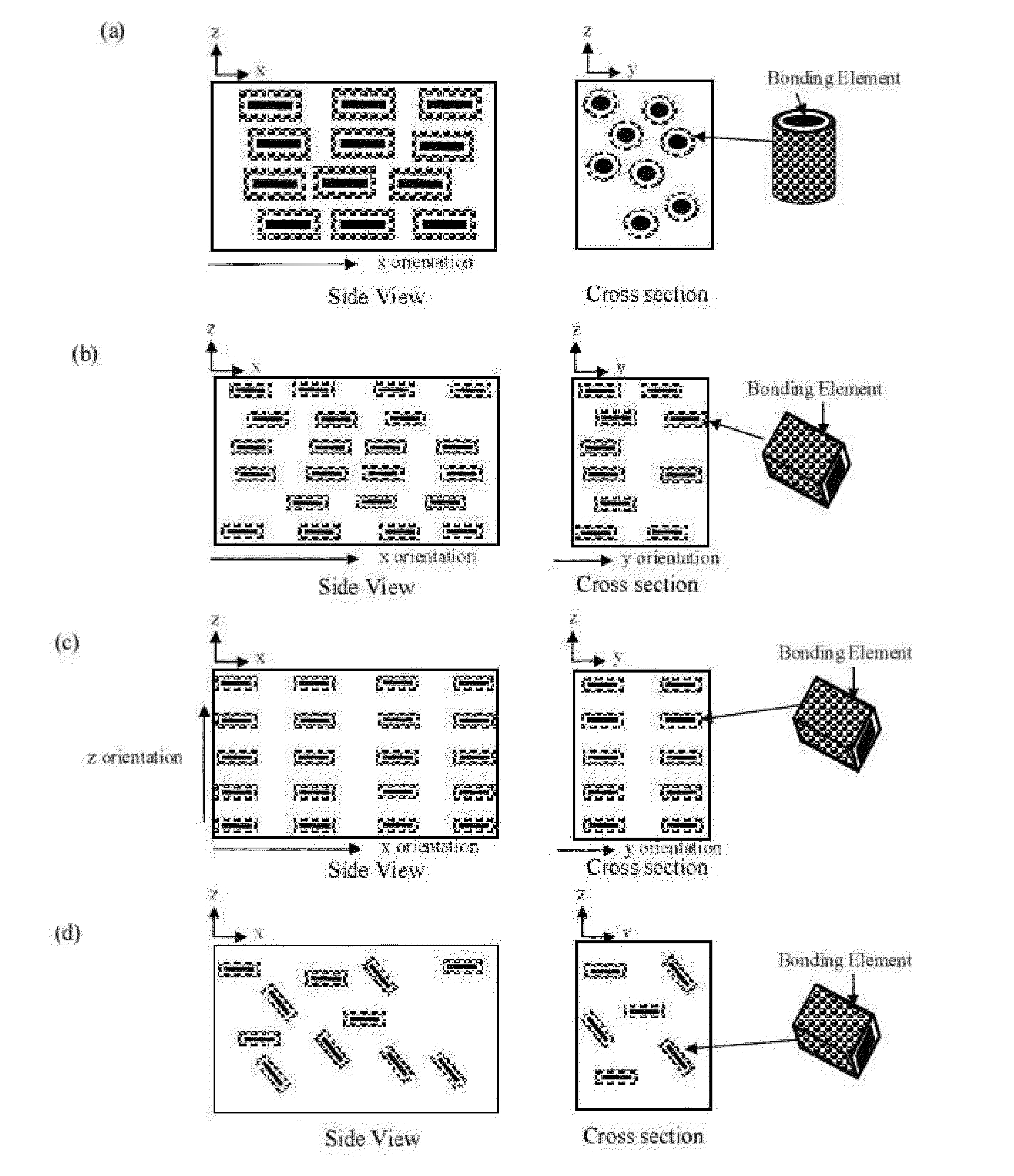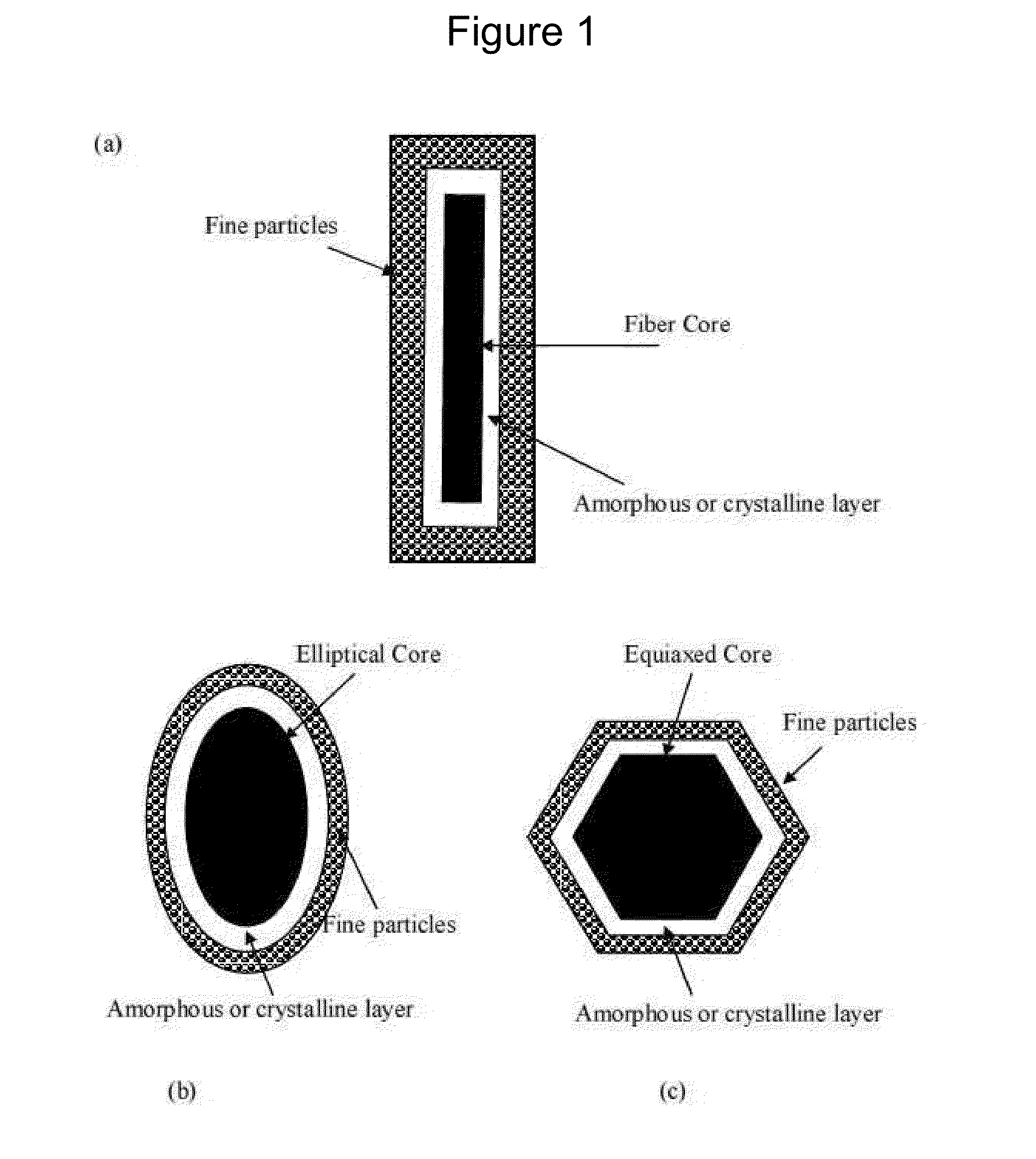Bonding element, bonding matrix and composite material having the bonding element, and method of manufacturing thereof
- Summary
- Abstract
- Description
- Claims
- Application Information
AI Technical Summary
Benefits of technology
Problems solved by technology
Method used
Image
Examples
working examples
Non-Limiting Working Examples
Example 1
[0139]FIGS. 5a and 5b show secondary electron (SE) and back scattered electron (BSE) SEM images of randomly oriented CaSiO3 core fibers coated by predominantly amorphous silica, and these coated fibers are encapsulated with CaCO3 particles. Chemical mapping by EDS in FESEM of the microstructure showed wollastonite core fibers are coated by SiO2 rich regions and encapsulated by CaCO3 particles (FIG. 6). Different elements of bonding matrix are held together by CaCO3 particles. XRD of this composition revealed that CaSiO3 and CaCO3 (calcite) are crystalline phases whereas silica rich regions are amorphous.
[0140]Table 6 compares mechanical properties of conventional monolithic materials with different compositions (Tables 3 and 4) formed by using a wollastonite core fiber-based bonding matrix. These bonding matrices showed a range of compressive strengths between 40 and 300 MPa. Moreover, compressive strength can be tailored by both the fiber core ...
example 2
[0149]FIG. 11 shows interaction of SiO2, high Ca Fly Ash (HCFA) and CaCO3 with P3 bonding matrix (P3 composition, Table 4). Observation of the P3 bonding matrix and SiO2 interface (FIGS. 11(a) and (b)) reveals that CaCO3 particles and silica-rich coating around wollastonite core fibers have formed a bonded interface with externally added silica particles. In P3 bonding matrix-HCFA interface there was no sign of debonding between the HFCA and bonding matrix (FIG. 11(b)). Similarly in P3 bonding matrix-CaCO3 interface, externally added CaCO3 particles have formed diffuse interfaces with bonding elements.
[0150]FIG. 12(a) shows a typical example of 0-3 composite, where 70 vol. % sand (silica) particulate components are dispersed in P3 bonding matrix with porosities in the structure (Table 4). This composite material showed a gradual failure during compression, and had a compressive strength of ≈55 MPa (FIG. 12(b)). 30 vol. % P3 bonding matrix is acting as the hydrate free cementing phas...
example 3
[0152]FIG. 15 shows the variation of thermal strain of FB 1B from −40 to 100° C. during thermal cycling for 2 consecutive cycles. No signs of thermal hysteresis, or phase changes were observed during thermal cycling. Table 10 summarizes thermal properties of P2 and P3 compositions. FIG. 16 shows variation of specific heat from RT to 500° C. of P3 (Table 4). Specific heat increased gradually from 0.711 (J / g2C) to 1.274 (J / g−° C.). No phase change or change in thermal properties of the P3 composition was observed. Clearly, similar types of bonding elements in their pure form, or incorporated into composite composition can be used in high temperature applications like fire resistance etc.
TABLE 10Summary of thermal properties of P2 and P3 compositions (Table 3)Physical PropertiesP3P2Thermal Conductivity1.7 (RT)1.0 (RT)(W / m · k)1.9 (250° C.)1.6 (250° C.)Specific Heat (J / g ° C.)0.7NAThermal Expansion (10−6 / ° C.)4.0NA
[0153]By using Table 10, thermal conductivity and thermal expansion of di...
PUM
| Property | Measurement | Unit |
|---|---|---|
| Time | aaaaa | aaaaa |
| Pressure | aaaaa | aaaaa |
| Pressure | aaaaa | aaaaa |
Abstract
Description
Claims
Application Information
 Login to View More
Login to View More - R&D
- Intellectual Property
- Life Sciences
- Materials
- Tech Scout
- Unparalleled Data Quality
- Higher Quality Content
- 60% Fewer Hallucinations
Browse by: Latest US Patents, China's latest patents, Technical Efficacy Thesaurus, Application Domain, Technology Topic, Popular Technical Reports.
© 2025 PatSnap. All rights reserved.Legal|Privacy policy|Modern Slavery Act Transparency Statement|Sitemap|About US| Contact US: help@patsnap.com



